Tag Archive: AAC intervention
February 3, 2020
by Carole Zangari -
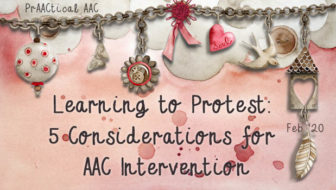
Stop it. No, thank you. Don’t do that. I don’t want ___. Not now. In order to be able to express what they are really thinking, AAC learners need the vocabulary and skills to be able to tell us when they don’t like something or when they do not want to participate. Here are some thoughts about facilitating their growth in this area. Review the vocabulary and messages that are available to the learner. Consider single words (e.g., no, not, stop) and contractions (e.g., don’t, can’t, won’t, shouldn’t), as well as prestored messages that will make it faster and easier to express themselves under stressful conditions when the need for protesting is most important (e.g., I don’t want to. I want you to stop. Don’t make me to that.). Model negation in various contexts. Narrate your own experiences throughout the day (e.g., I don’t want to eat that. Stop touching... [Read More...]
Filed under: Featured Posts, PrAACtical Thinking
Tagged With: AAC intervention, protesting, rejecting
January 31, 2019
by Carole Zangari -
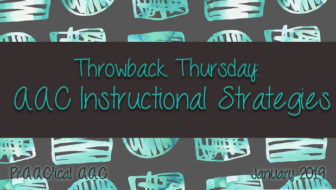
Engaging activities and materials are important in AAC instruction, but the real magic happens when we implement appropriate intervention strategies with fidelity and on a consistent basis. For Throwback Thursday, we raided the archives to revisit some previous posts on several key intervention strategies. Aided Language Input: How Much Language Should We Model? Aided Language Input in AACtion “I’m Using Aided Language Input. Now what??” From Referential to Descriptive Teaching with AAC Learners Recasting: A Language Facilitation Strategy F is for Feedback
Filed under: Featured Posts, PrAACtical Thinking
Tagged With: AAC intervention, intervention strategies
April 5, 2018
by Carole Zangari -
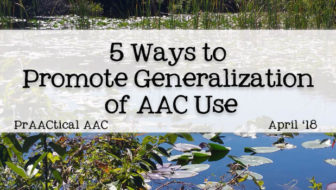
Do you work with AAC learners who demonstrate their communication skills in therapy or instructional lessons, but not elsewhere? In this post, we review some things we can do to make it easier for AAC learners to generalize their newly-developed skills and use them in a variety of places with a range of communication partners. Part of the solution to this problem lies in collaborating with the communication partners in other settings. In doing that, we want to be sure that the partners use good communication facilitation strategies, such as these. Partner skills are something we’ve covered here on several occasions. Today, we’ll focus on changes we can make within our direct intervention or instructional lessons with AAC learners. Initially, we may control some of the instructional variables, such as materials and cues, rather tightly. Keeping things consistent is great for the initial teaching of new skills because it allows... [Read More...]
Filed under: Featured Posts, PrAACtical Thinking
Tagged With: AAC intervention, generalization, loose training
May 9, 2016
by Carole Zangari -
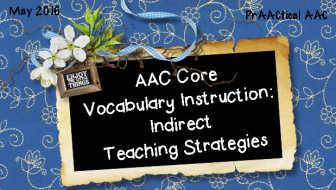
It has been so exciting to see that AAC learners are increasingly provided with communication boards, books, SGDs, and apps that feature a robust set of core vocabulary words. For many years, ‘providing AAC’ used to mean access to topic and choice boards or activity-specific communication displays (ABCDs). Now, we recognize the limitations of those approaches and do our best to move beyond them in favor of more linguistically robust options. AAC systems with core vocabulary that is organized to support the development of a motor plan allows learners to build and grow their skills over time. For a long time, the AAC field has known that providing access to appropriate tools (in this case, a core vocabulary set) is only the first step toward successful use of augmentative communication. Providing it is necessary but not sufficient for most AAC learners to develop any sort of linguistic competence. For... [Read More...]
Filed under: Featured Posts, PrAACtical Thinking
Tagged With: AAC intervention, implementation, language therapy
March 23, 2015
by Carole Zangari -
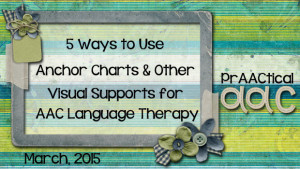
Anchor charts are a visual way to outline, describe, or illustrate a procedure, strategy, or concept. They are widely used visual supports in general education classrooms across the grade levels. In AAC therapy, anchor charts offer several benefits. First, making the anchor chart forces us to distill the main ideas in whatever it is we are teaching. What are the key aspects of what we are teaching? We have to answer that to create our anchor chart, and that gets us really thinking about the concept/process/strategy in great detail. Selecting the critical elements for our anchor chart helps us focus on the constructs that are most important to teach. Secondly, it helps us explain the concept/process/strategy in a more concise and articulate way. Putting things into writing forces us to clarify our explanations, and allows us to carefully consider what to say and how to say it. Yes, we sometimes... [Read More...]
Filed under: PrAACtical Thinking
Tagged With: AAC intervention, anchor charts, implementation ideas, visual supports
November 25, 2013
by Carole Zangari -

As any experienced AAC professional will tell you, people who are learning to use AAC systems don’t produce as much verbal output as their speaking peers. And, every once in awhile, we run into an AAC learner who communicates VERY infrequently even though they are capable of doing more. They’re often described as shy (perhaps) or stubborn (cringe! shudder! clench teeth!), but, in our view, their reluctance to communicate is probably related to a few other things. We generally don’t like to do things that are difficult for us, particularly if the pay-off is not in proportion to the effort, or if there are insufficient supports. If the learner has had a history of being unsuccessful or associates communication with a high level of effort, it makes sense that they are not rushing to interact with us. It doesn’t always pay to rush things. Sometimes we get better outcomes by building... [Read More...]
Filed under: PrAACtical Thinking
Tagged With: AAC intervention, intervention strategies, reluctant communicator, self-confidence, trust
January 2, 2013
by Carole Zangari -
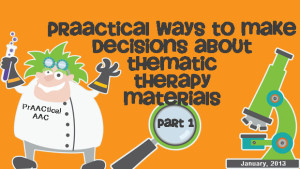
Is it just us, or have other people been blown away by the number of SLPs sharing therapy materials that they’ve designed? It seems like every time we visit sites like Facebook, Pinterest, and TeachersPayTeachers, there are more SLPs posting things that they’ve made. Most of them are incredibly adorable, reasonably priced, and even free. Many are based around a particular theme, such as a holiday or season, or a conceptual theme, such as pirates, the circus, or outer space. We love the cute graphics and fun fonts, and bet that many of you do, too. Cuteness and the ‘fun factor’ are compelling, but which ones are a good fit for your AAC therapy? In this post, we want to open a conversation with prAACtical thoughts about making solid clinical decisions when choosing therapy materials. I’ll be sharing some things that can be helpful when working with kids who have... [Read More...]
Filed under: PrAACtical Thinking
Tagged With: AAC intervention, clinical considerations, clinical decisions, intervetion, materials, pedagogy, theory, therapy






